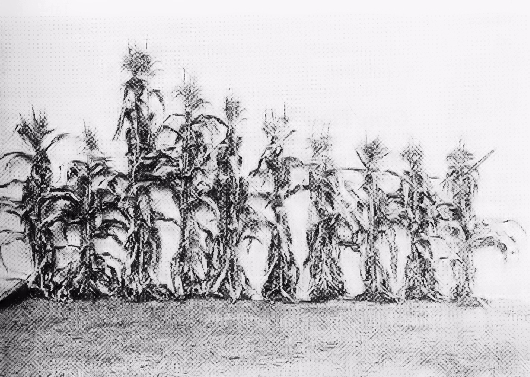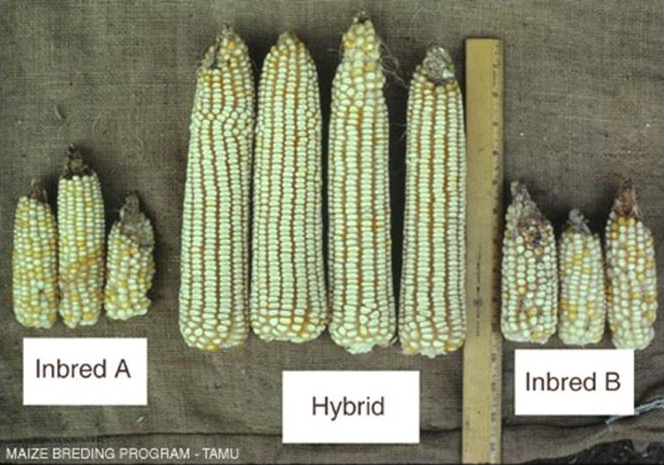

Hybrid Vigor
in maize (Zea)
Early (left) and Later (right) experiments with improved
yield of maize (Zea). The 1924 photo at left show the
result of crossing two inbred lines of Zea [first
two plants]. The F1 hybrid
plant [third plant] is somatically more vigorous and
produced larger ears of corn. This "hybrid vigor"
is attributed to a positive effect of the creation of
heterozygosity at many loci simultaneously, a phenomenon
called heterosis.
Successive generations of back-crossing of this
hybrid line to itself show successively less vigorous plants
[decline in size of plants]. Some of this may be attributed
to reinforcement of deleterious recessives from one or the
other of the parental lines in the F2
and later generations. The heterosis effect was regarded as
an interesting but impractical method for crop improvement.
The photo on the right shows a more recent experiment. As before, the two P1 lines are inbred, and somatically weak. The F1 hybrid is much more vigorous, and has demonstrably greater crop yield. Instead of letting the hybrid line self-fertilize in the F2, it is deliberately modified genetically to be self-sterile. Hybrid seed can then be produced in greater quantity in any one season, and used over several growing seasons. Choice of different parental lines produces hybrids with favorable characteristics for different growing conditions. Hybrid corn produced in this manner went from being a rarity to a standard means of production in the US in the 1930s.
Hybrid vigor differs from Heterosis in that the former is the result of a cross in which the hybrid offspring are necessarily heterozygous at most or all loci. A correlation between somatic vigor and measured number of heterozygous loci relies on an assumption that the observed loci are responsible for the trait of interest, and (or) that the observed loci are an accurate estimate of overall heterozygosity. The heterotic effect is not necessarily attributed to any loci in particular.
The photo on the right shows a more recent experiment. As before, the two P1 lines are inbred, and somatically weak. The F1 hybrid is much more vigorous, and has demonstrably greater crop yield. Instead of letting the hybrid line self-fertilize in the F2, it is deliberately modified genetically to be self-sterile. Hybrid seed can then be produced in greater quantity in any one season, and used over several growing seasons. Choice of different parental lines produces hybrids with favorable characteristics for different growing conditions. Hybrid corn produced in this manner went from being a rarity to a standard means of production in the US in the 1930s.
Hybrid vigor differs from Heterosis in that the former is the result of a cross in which the hybrid offspring are necessarily heterozygous at most or all loci. A correlation between somatic vigor and measured number of heterozygous loci relies on an assumption that the observed loci are responsible for the trait of interest, and (or) that the observed loci are an accurate estimate of overall heterozygosity. The heterotic effect is not necessarily attributed to any loci in particular.